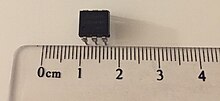Solid-state relay
This article relies largely or entirely on a single source. (February 2015) |



A solid state relay (SSR) is an
SSRs consist of a sensor which responds to an appropriate input (control signal), an electronic switching device which switches power to the load circuitry, and a coupling mechanism to enable the control signal to activate this switch without mechanical parts. They may be designed to switch either AC or DC loads. Packaged SSRs use power semiconductor devices such as thyristors and transistors, to switch currents up to around a hundred amperes. SSRs have fast switching speeds compared with electromechanical relays, and have no physical contacts to wear out. SSRs are unable to withstand a large momentary overload the way an electromechanical relay can, and have a higher "on" resistance.
Operation
In AC circuits,
An SSR based on a single MOSFET, or multiple MOSFETs in a paralleled array, can work well for DC loads. MOSFETs have an inherent substrate diode that conducts in the reverse direction, so a single MOSFET cannot block current in both directions. For AC (bi-directional) operation two MOSFETs are arranged back-to-back with their source pins tied together. Their drain pins are connected to either side of the output. The substrate diodes are alternately reverse biased to block current when the relay is off. When the relay is on, the common source is always riding on the instantaneous signal level and both gates are biased positive relative to the source by the photo-diode.[vague]
It is common to provide access to the common source so that multiple MOSFETs can be wired in parallel if switching a DC load. Usually a network is provided to speed the turn-off of the MOSFET when the control input is removed.
SSRs for DC switching applications may use MOSFETs or
Timing
Selection of the appropriate type of SSR[2] is important, especially when the application calls for time critical On/Off condition with no variation.
Applications which require Time Critical On/Off switching, should use Transistor or MOSFET design types as they are not subject to the inherent Zero Cross variations that SCR or TRIAC devices will exhibit.
Coupling
The control signal must be coupled to the controlled circuit in a way which provides galvanic isolation between the two circuits.
Many SSRs use optical coupling. The control voltage energizes an internal
Characteristics
Most of the relative advantages of solid state relays over electromechanical relays are common to all solid-state devices when compared to electromechanical devices.
- Totally silent operation.[3]
- SSRs switch faster than electromechanical relays; the switching time of a typical optically coupled SSR is dependent on the time needed to power the LED on and off - on the order of microseconds to milliseconds.[3]
- Increased lifetime, even if it is activated many times, as there are no moving parts to wear and no contacts to pit or build up carbon.[3]
- Clean, bounceless operation.[3]
Parameters
This section needs expansion. You can help by adding to it. (September 2010) |
SSRs are characterised by a number of parameters including the required activating input voltage, current, output voltage and current, whether it is AC or DC,
See also
References
- ^ "Solid State Relays". Sensata Technologies. Retrieved 2023-02-01.
- OCLC 15132642.
- ^ a b c d "Solid State Relay". Infineon Technologies. Retrieved 2021-02-03.
